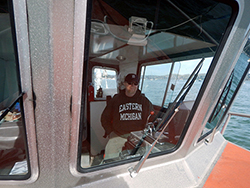
Environmental Scientist Tom Greiner at the helm of CDFW research vessel Triakis.
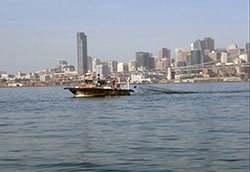
CDFW Research Vessel Triakis on San Francisco Bay
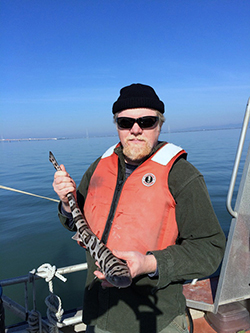
Greiner holds a young leopard shark
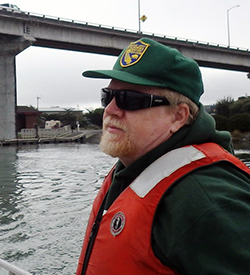
Greiner on Humboldt Bay
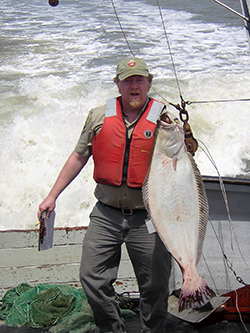
Tom Greiner… just for the halibut
Thomas Greiner is an environmental scientist for the Aquaculture and Bays Management Project in CDFW’s Marine Region. He has more than 23 years experience with the department. Based out of the Santa Rosa office, his main duties include monitoring and management of the commercial herring fishery in San Francisco Bay and biological assessment of California’s estuaries.
Tom earned a double major in general Biology and Fine Arts from Eastern Michigan University. He came to CDFW in 1989 as a scientific aid. Afterwards he pursued a Master’s degree at Humboldt State University. After another stint as a scientific aide, Tom was hired as a Senior Laboratory Assistant for the CDFW’s San Francisco Bay Study and later promoted to Marine Biologist and Associate Biologist and is now an Environmental Scientist.
Who or what inspired you to become a scientist?
I have had an interest in nature, and animals in particular, since I was knee-high to a porcupine. My mother’s willingness to put up with all sorts of critters in the house certainly paved the way. Along the way several people tried to warn me that there are very few jobs in natural resources, but my stubbornness won out.
Can you give us an overview of the herring fishery and tell us why it’s important?
The primary commercial herring fishery in California occurs in San Francisco Bay. It is primarily a roe fishery with its product exported to Japan, where it is considered a delicacy and is a traditional holiday gift. There is also a smaller herring-eggs-on-kelp fishery and a fresh fish fishery for local consumption. In addition, there is a sport fishery for bait and food.
The San Francisco Bay herring fishery was once highly profitable, but a reduction in the price per ton paid to commercial fishers, due to competition from other fishing areas and diminishing demand in Japan, has led to reduced fishing effort.
What is a typical day like for you at work?
A typical day is spent in the office manipulating data and writing or editing documents, but work still takes me out into the field. In the summer, I occasionally help with fish rescues or sample the local estuaries by kayak using beach seines. Winter is my busy field season. I sample Pacific herring in San Francisco Bay aboard a research vessel by deploying a mid-water trawl. On a trawl day I typically get up long before sunrise and meet the crew, which consists of one boat operator (me or one of the other Herring Team biologists) and two winch operators. Once on the water, we look for cormorants, gulls, seals and sea lions to help us find schools of fish. After we have found a school, the vessel operator plans a strategy for the trawl which includes assessing potential hazards, determining tow direction (we tow with the current), and amount of line we need to let out to get the net down to the school of fish. We avoid trawling in rough seas or swift currents, but things can still get dicey – between vessel breakdowns, tangling up or ripping the net, and getting the net stuck in the substrate, trawling is often an adventure.
We collect data on age, length, weight and reproductive status from these samples. We use this data to assess condition of the San Francisco Bay Pacific herring spawning population. This information, along with a spawning biomass estimate made by another Herring Team member, is used to set the next season’s commercial fishing quota.
Managing the quota requires up to the hour information on herring fishing activity and landings along with coordinated, decisive action when calling for closure of the fishery to prevent over-exploitation of the herring resource. I coordinate fishery closures with the Herring Team, CDFW enforcement and the U.S. Coast Guard.
What is it about the work you do that you find most interesting or rewarding?
It is very rewarding working as part of a well-oiled (okay, occasionally squeaky) team to protect our natural resources. Precision teamwork is required both in the management of the commercial fishery and safely operating our sampling vessel.
What is the accomplishment you’re most proud of?
There isn’t one single accomplishment that I pride myself on above others, but instead it is my dependable, consistent, quality work. Through many years of study, I have developed a good reputation for reliable identification of estuarine fish and macroinvertebrate species. Continuous identification practice is important as I recently had a SNAFU concerning juvenile jacksmelt and topsmelt IDs – juvenile fish identification can be very tricky and the characteristics used to differentiate species in adult fish don’t always apply to the little guys.
If you had free reign and unlimited funding, what scientific project would you most like to do?
Restoring and protecting habitat and native wildlife and monitoring the recovery would be very rewarding. Healthy and varied habitat is often the key component in an ecosystem. One nice part is that this can be done on a small scale and some benefits may still be observed. Planting one tree can make a difference, especially in an urban area that lacks trees.
Are you a recreational angler (or hunter) yourself?
It has been quite a while, but I occasionally fish for food. I think that my main purpose in fishing is to make my friends feel good because they catch more fish than I do. It’s been much longer since I’ve hunted, but I also support the idea of hunting for food.
Do you have any advice for people considering careers in science or natural resources?
Get a degree in biological sciences, natural resources or related field. Meeting working biologists is very helpful and volunteering shows motivation. Be flexible in the job locations and positions that you are willing to accept. Very few people get permanent positions with CDFW right out of college. You need to have persistence, persistence, persistence, grit and patience. And learn to be frugal – you won’t make a lot of dough in this profession.
Top Photo: Tom Greiner, Arn Aarreberg and Ryan Watanabe identify and measure fish and invertebrates sampled by beach seine from Estero de San Antonio, a coastal lagoon in northern Marin County.